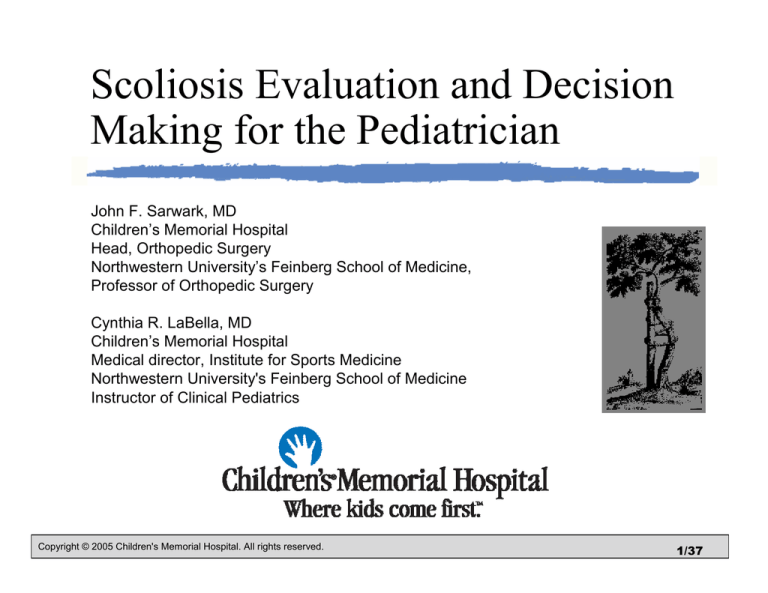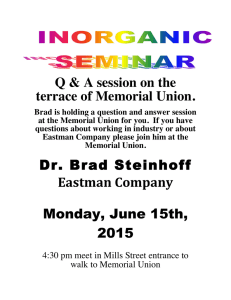
Scoliosis Evaluation and Decision
Making for the Pediatrician
John F. Sarwark, MD
Children’s Memorial Hospital
Head, Orthopedic Surgery
Northwestern University’s Feinberg School of Medicine,
Professor of Orthopedic Surgery
Cynthia R. LaBella, MD
Children’s Memorial Hospital
Medical director, Institute for Sports Medicine
Northwestern University's Feinberg School of Medicine
Instructor of Clinical Pediatrics
Copyright © 2005 Children's Memorial Hospital. All rights reserved.
1/37
Scoliosis: Overview
•
•
•
•
•
•
Definition
Etiologies
Making the diagnosis
When to refer
Natural history/prognosis
Treatment
Copyright © 2005 Children's Memorial Hospital. All rights reserved.
2/37
Scoliosis is strictly defined
• Cobb angle measurement on Xray:
• Lateral curvature > 10°
Copyright © 2005 Children's Memorial Hospital. All rights reserved.
3/37
Scoliosis: Etiologies
• Two categories
• Structural
• Non-structural
Copyright © 2005 Children's Memorial Hospital. All rights reserved.
4/37
Non-structural etiologies
•
•
•
•
Leg length discrepancy
Inflammation
Neurogenic / disc pathology
Hysterical
Copyright © 2005 Children's Memorial Hospital. All rights reserved.
5/37
Structural etiologies
•
•
•
•
Idiopathic (most common)
Congenital
Neuromuscular (e.g. cerebral palsy)
Miscellaneous (lengthy list)
Copyright © 2005 Children's Memorial Hospital. All rights reserved.
6/37
Miscellaneous scoliosis: examples
• Associated with other conditions
• Osteoid osteoma
• Metabolic
• Rickets
• Osteogenesis Imperfecta
• Infection (late sequela)
• Limb deficiency syndromes
• Burn scar (truncal)
• Congenital heart disease
• Chest wall asymmetries
Copyright © 2005 Children's Memorial Hospital. All rights reserved.
7/37
Morquio-Brailsford Syndrome
• Mucopolysaccharidosis
• Spine normal at birth
• Kyphoscoliosis develops with
growth
• Usually also present:
• Odontoid hypoplasia
• Short stature
• Aortic valve abnormalities
• Hearing loss
• Corneal opacities
Copyright © 2005 Children's Memorial Hospital. All rights reserved.
8/37
Neurofibromatosis
• Spine involvement
is common
• Often exhibit bony
dyplasia
• Curves tend to be
sharp and
progressive
Copyright © 2005 Children's Memorial Hospital. All rights reserved.
9/37
Osteoid Osteoma
Night pain
Limited spinal mobility
Tenderness
Xray may reveal classic
features
• Bone scan often
diagnostic
•
•
•
•
Copyright © 2005 Children's Memorial Hospital. All rights reserved.
10/37
Marfan Syndrome
Scoliosis develops in most cases
Often have double and triple curves
Curves start earlier
Curves are more progressive, resistant,
and rigid
• Brace management less effective
•
•
•
•
Copyright © 2005 Children's Memorial Hospital. All rights reserved.
11/37
Normal Spinal Alignment
• Anteroposterior view……0° curvature
• Sagittal (lateral) view
• Thoracic kyphosis……….20-40° (varies)
• Lumbar lordosis…………40-60° (varies)
Copyright © 2005 Children's Memorial Hospital. All rights reserved.
12/37
Idiopathic Scoliosis
• Idiopathic scoliosis
with onset after age
10 is most common
and classic form
Copyright © 2005 Children's Memorial Hospital. All rights reserved.
13/37
Idiopathic Scoliosis: Incidence
• 2% referred after screen
• 0.3% require treatment
• Female:male – 7:1 (at >30°)
Copyright © 2005 Children's Memorial Hospital. All rights reserved.
14/37
Idiopathic Scoliosis: Incidence
• Incidence of scoliosis in
relation to curve magnitude
• Most scoliosis is low
magnitude
Copyright © 2005 Children's Memorial Hospital. All rights reserved.
15/37
Scoliosis: Diagnosis
The physical examination is the first line of
detection
Copyright © 2005 Children's Memorial Hospital. All rights reserved.
16/37
Scoliosis: Clinical Examination
• Inspection
• Shoulder height asymmetry
• Scapular prominence
• Waist line asymmetry
• Flank crease
• Pelvic asymmetry
• Adams Forward Bend Test
• Sine qua non for scoliosis
evaluation
Copyright © 2005 Children's Memorial Hospital. All rights reserved.
17/37
The Screening Exam
• Adam’s Forward Bend Test
• Prominence is accurately measured using
scoliometer
• Scoliometer measures the angle of trunk rotation
(ATR)
• Misleading traps
• Pelvis level? (LLD?)
• Back pain
Copyright © 2005 Children's Memorial Hospital. All rights reserved.
18/37
Scoliometer measures ATR
Copyright © 2005 Children's Memorial Hospital. All rights reserved.
19/37
Angle of trunk rotation (ATR)
Copyright © 2005 Children's Memorial Hospital. All rights reserved.
20/37
ATR Correlates With Cobb Angle
Copyright © 2005 Children's Memorial Hospital. All rights reserved.
21/37
Location of Curve
Copyright © 2005 Children's Memorial Hospital. All rights reserved.
22/37
When to Refer
• Refer when:
• ATR >5-7 degrees or
• Cobb angle >20 degrees
• False negative (“missed”) – 0.1%
• False positive (over-referred) – 5%
Copyright © 2005 Children's Memorial Hospital. All rights reserved.
23/37
Scoliosis: Natural history
• Effects of growth
and puberty
Copyright © 2005 Children's Memorial Hospital. All rights reserved.
24/37
Natural History of Curve Progression
in Idiopathic Scoliosis
• Curves < 30° are stable
• Curves > 50° tend to progress
• Avg. rate = 1°/year
• Factors in curve progression
• Vertebral rotation
• Translatory shifts
Weinstein
• Curve severity
JBJS 65A:447,
1983
Copyright © 2005 Children's Memorial Hospital. All rights reserved.
25/37
Natural History
Curve progression is
defined as increase
of 5 or more degrees
Copyright © 2005 Children's Memorial Hospital. All rights reserved.
26/37
Risk Factors for Progression
•
•
•
•
Magnitude of curve at presentation
Curve location
Level of maturation
Risser grade
• Extent of iliac crest ossification on AP Xray
Copyright © 2005 Children's Memorial Hospital. All rights reserved.
27/37
Long Term Sequelae
• Cosmetic deformity
• Psychosocial effects
• No increased back pain in general – except
for T-L curves as adults
• If curve is >80°
• Cor Pulmonale
• If curve is >100°
• Cardiopulmonary death (rare)
Copyright © 2005 Children's Memorial Hospital. All rights reserved.
28/37
Physical Deformity
• Coronal plane curve –
“Cobb angle”
• Sagittal plane –
Hypokyphosis !
• Rotational deformity rib
effect
Copyright © 2005 Children's Memorial Hospital. All rights reserved.
29/37
Psychosocial effects
• Scoliosis has been shown to increase risk of
• Suicidal thought
• Worry
• Concern over body image
• Support groups and counseling may be
appropriate
Copyright © 2005 Children's Memorial Hospital. All rights reserved.
30/37
Non-Prognostic Factors
• Factors that do not predict curve
progression
• Family history
• Thoracic kyphosis
• Lumbar lordosis
• Lumbosacral anomalies
• Trunk balance
Copyright © 2005 Children's Memorial Hospital. All rights reserved.
31/37
Impact of Early Presentation
and Diagnosis
•
•
•
•
•
Earlier detection
Smaller curves are easier to treat
Conservative treatment more likely
Surgery needed less often
If surgery is needed:
• Less complex
• Earlier intervention may have greater
impact on prognosis
Copyright © 2005 Children's Memorial Hospital. All rights reserved.
32/37
Scoliosis treatment
• Treatment options are based on natural
history and curve severity
Copyright © 2005 Children's Memorial Hospital. All rights reserved.
33/37
Copyright © 2005 Children's Memorial Hospital. All rights reserved.
34/37
Copyright © 2005 Children's Memorial Hospital. All rights reserved.
35/37
Scoliosis Treatment Summary
Copyright © 2005 Children's Memorial Hospital. All rights reserved.
36/37
Thank you
Copyright © 2005 Children's Memorial Hospital. All rights reserved.
37/37


